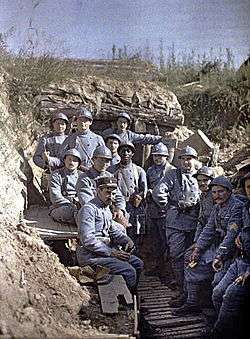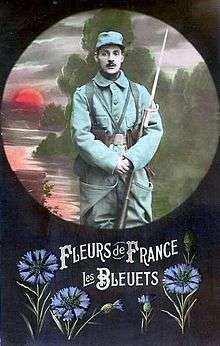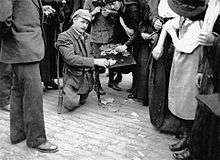Bleuet de France
In France, the bleuet de France is the symbol of memory for, and solidarity with, veterans, victims of war, widows, and orphans, similar to the British Commonwealth remembrance poppy. The sale of "bleuet de France" badges on 11 November and 8 May is used to finance charitable works for those causes.
Origins

In the language of flowers, the cornflower symbolizes delicacy and timidity, and indicates that a message has a pure, innocent, or delicate intention.
The cornflower – like the poppy – continued to grow in land devastated by the thousands of shells which were launched daily by the entrenched armies of the Western Front. These flowers were often the only visible evidence of life, and the only sign of color in the mud of the trenches.
At the same time, the term "bleuets" was used also to refer to the class of conscripted soldiers born in 1895 who arrived in the lead-up to the Second Battle of the Aisne, because of the bleu horizon worn by French soldiers after 1915. The uniform worn by these recruits, many of whom were not even twenty years old, was distinctive because it marked a break from the garance red trousers worn by older soldiers, which were part of the standard uniform before the First World War.[1]
As the war dragged on and the novelty of the term faded, the title endured because the uniforms that fresh arrivals wore into the trenches were still new and brightly colored, in contrast with the mud-stained uniforms of veteran troops.
The popularity of the term was such that the image became a potent symbol in postcards, posters, songs, and poems:

| «Les voici les p’tits « Bleuets » | These here, these little "Bleuets" | ||
| Les Bleuets couleur des cieux | These Bleuets the color of the sky, | ||
| Ils vont jolis, gais et coquets, | Are beautiful, gay, stylish, | ||
| Car ils n’ont pas froid aux yeux. | Because they are not afraid. | ||
| En avant partez joyeux ; | Merrily, go forward | ||
| Partez, amis, au revoir ! | Go on, my friends, so long! | ||
| Salut à vous, les petits « bleus », | Good luck for you, little "blues" | ||
| Petits « bleuets », vous notre espoir ! » | Little "bleuets," you are our hope! |
- –Alphonse Bourgoin, from Bleuets de France, 1916.[2]

The origin of the badge dates to 1916. It was created by Suzanne Lenhardt, head nurse in Les Invalides, and Charlotte Malleterre. Lenhardt was the widow of a Colonial Infantry captain killed in 1915, and Malleterre was the sister of Général Gustave Léon Niox and the wife of Général Gabriel Malleterre. They were both moved by the suffering endured by the war wounded for whom they were responsible and, needing to provide them with some activity, organized workshops where cornflower badges were made from tissue paper. These were sold to the public at various times, with the money collected providing the men a small income.[3] They gradually became a symbol of the rehabilitation of soldiers through labor.
On 15 September 1920, Louis Fontenaille, the president of Mutilés de France, proposed making the blueut the eternal symbol of those who died for France. This had the support of the FIDAC (Federation Interalliee des Anciens Combattants).
In 1928, after French President Gaston Doumergue gave his patronage to the bleuet, sales gradually spread countrywide. By 11 November 1934, 128,000 flowers were sold. From 1935, the French government officialized the sale of bleuets on Remembrance Day.
In 1957, a second commemorative day was denoted for 8 May, VE day, the anniversary of the surrender of Nazi Germany in the Second World War.
See also
Sources
- Lindecker, Jacques (1999). Les Bleuets de l'Espoir. Éditions Nathan. ISBN 2092824805.
- Rouaud, Jean (1990). Les Champs d'honneur. Éditions de Minuit. ISBN 2707313475.
- Japrisot, Sébastien (1991). Un long dimanche de fiançailles. Denoël. ISBN 2207236102.
References
- ↑ Marival, Guy (November 2007). "Des bleuets par milliers…" (PDF). La lettre du Chemin des Dames n° 12 (in French).
- ↑ Bourgoin, Alphonse; Gillard, F. (Music) (1916). "Bleuets de France". Chansons et poèmes de guerre [War songs and poems]. Paris: Bloud et Gay.
- ↑ "Guerre 14 18 en Alsace – Le symbole du bleuet." [14-18 war in Alsace - the bleuet symbol]. alsace1418.fr (in French). 25 December 2009. Retrieved 3 November 2016.